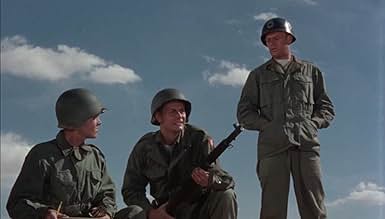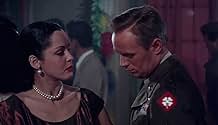AVALIAÇÃO DA IMDb
6,0/10
1,2 mil
SUA AVALIAÇÃO
Adicionar um enredo no seu idiomaIn 1953 at Fort Bliss, Texas, two Korean War combat veterans work as drill sergeants and fall in love with the same woman.In 1953 at Fort Bliss, Texas, two Korean War combat veterans work as drill sergeants and fall in love with the same woman.In 1953 at Fort Bliss, Texas, two Korean War combat veterans work as drill sergeants and fall in love with the same woman.
- Indicado a 1 Oscar
- 1 indicação no total
Iris Adrian
- Mrs. Butterfly
- (cenas deletadas)
Acquanetta
- Bar Girl
- (não creditado)
Matilda Caldwell
- Mrs. Hazard
- (não creditado)
Charlita
- Mexican Girl
- (não creditado)
John Close
- Military Policeman
- (não creditado)
Avaliações em destaque
An utterly routine military film, minus anything that might distinguish it from the many other recruiting posters of the time, e.g. The DI (1957), Battle Cry (1955), et al. Except for the first few minutes of combat in Korea, the remainder is taken up with Basic Training at Fort Bliss, TX. Widmark gets the stereotypical role of an emotionally crippled drill sergeant, while Malden is wasted as his straight-arrow assistant. Third billed Stewart is the required love interest, who unfortunately is all hair and little talent. The remainder of the cast fills out the ranks of recruit trainees, with the usual array of witty or problem personalities. The movie's one notable feature turns up in the multi-racial ranks of the trainees, a relatively new updating for Hollywood.
As a guy who went through Basic (at Ft. Bliss in the 60's), I have to agree with reviewer bkoganbing. Many of the incidents portrayed in the film would never have occurred in real training, especially Malden slugging Widmark in front of the trainees. But I guess the screenplay needed more action at that point. Then too, the language was really cleaned up for public viewing. I had to laugh every time Widmark benignly called the recruits "young people".
What surprises me is the movie's director, Richard Brooks. How he got the job of supervising this sort of pablum is a puzzle, having built a reputation for highly serious work as a screenwriter, Brute Force (1948), Crossfire (1947), et al. Anyway, the movie is fairly typical of the sanitized type of military drama of the 1950's, before the stark realities of Vietnam sank in. (Contrast Basic Training here with it's more starkly realistic counterpart in Full Metal Jacket {1987}.) All in all, Take The High Ground is little more than a bland period curiosity.
As a guy who went through Basic (at Ft. Bliss in the 60's), I have to agree with reviewer bkoganbing. Many of the incidents portrayed in the film would never have occurred in real training, especially Malden slugging Widmark in front of the trainees. But I guess the screenplay needed more action at that point. Then too, the language was really cleaned up for public viewing. I had to laugh every time Widmark benignly called the recruits "young people".
What surprises me is the movie's director, Richard Brooks. How he got the job of supervising this sort of pablum is a puzzle, having built a reputation for highly serious work as a screenwriter, Brute Force (1948), Crossfire (1947), et al. Anyway, the movie is fairly typical of the sanitized type of military drama of the 1950's, before the stark realities of Vietnam sank in. (Contrast Basic Training here with it's more starkly realistic counterpart in Full Metal Jacket {1987}.) All in all, Take The High Ground is little more than a bland period curiosity.
While this may not be the movie that made me want to join the Army in 1956, it may have helped. The plot is a formulaic coming of age in basic training story, turning boys into men. The personal interactions and love affairs of Widmark and Malden, the veterans of Korea who are now leading a trainng platoon at Fort Bliss, Texas, next to El Paso are also formulaic.
The real value of this picture is as a time capsule. Nothing herein is BS, dreamed up, or recreated such as are Platoon, or Full Metal Jacket or Apocalypse Now, to mention some more modern highly praised but highly fictionalized films. Nor is it an anachronistic mish mash such or a low budget BW cheapie such as many of that period were.
Everything shown here is as it was at the time of filming and the background extras and other military individuals were actually going through infantry training with the real possibility of going to combat in Korea when it was being made. (An amusing aspect is that the opening scene of the newly arrived trainees and the disciplined troops entraining for their new assignments were filmed on the same day with the same Southern Pacific locomotive and equipment. Yet supposedly took place three months apart.)
Other time capsule films of the time are Bombers B-57, and Strategic Air Command, which prove that officially approved films can be entertaining and informative both.
The real value of this picture is as a time capsule. Nothing herein is BS, dreamed up, or recreated such as are Platoon, or Full Metal Jacket or Apocalypse Now, to mention some more modern highly praised but highly fictionalized films. Nor is it an anachronistic mish mash such or a low budget BW cheapie such as many of that period were.
Everything shown here is as it was at the time of filming and the background extras and other military individuals were actually going through infantry training with the real possibility of going to combat in Korea when it was being made. (An amusing aspect is that the opening scene of the newly arrived trainees and the disciplined troops entraining for their new assignments were filmed on the same day with the same Southern Pacific locomotive and equipment. Yet supposedly took place three months apart.)
Other time capsule films of the time are Bombers B-57, and Strategic Air Command, which prove that officially approved films can be entertaining and informative both.
I could tell this plot less film would go downhill from the beginning. In the opening scene we see a platoon of soldiers attacking a North Korean position, and one of them casually stops for a drink and is shot by an enemy soldier with a U.S. Army M1 rifle! That a real soldier would do this under fire, and that the props department couldn't afford an AK-47 speaks volumes about this film.
Then we go to Fort Bliss for what is supposed to be boot camp but is actually a summer camp for teenagers. I say this as an Army veteran.
Richard Widmark was on loan to the studio that made this film, but I think he should have remained with his contract studio, for I don't believe "Take the High Ground" was a milestone of his career.
Then we go to Fort Bliss for what is supposed to be boot camp but is actually a summer camp for teenagers. I say this as an Army veteran.
Richard Widmark was on loan to the studio that made this film, but I think he should have remained with his contract studio, for I don't believe "Take the High Ground" was a milestone of his career.
An interesting Korean-War era film, starring Richard Widmark and Karl Malden, Take the High Ground depicts sixteen weeks of basic training at Fort Bliss. The film revolves around the differing personalities of two drill sergeants (Widmark and Malden) as they shape hopeless recruits into combat-ready soldiers. Widmark's character, Sgt. First Class Thorne Ryan is a battle-hardened veteran, who believes that toughness is the best way to prepare recruits for combat. Staff Sgt. Laverne Holt (Malden), however, relies on compassion to help his men adjust to army life. These differences present a few interesting conflicts, but overall, their static characters add little. Like most basic training films, this movie offers a few predictable laughs and trivial subplots, but fails to develop a deep plot. Elaine Stewart's adulterous character, in particular, is unnecessary and only adds confusion. Overall, however, Take the High Ground is watchable, if not memorable.
Okay, this is not a great movie when considering it in the war movie genre or side by side with some of the classics that both Richard Widmark and Karl Malden made, but I will always think this as one of my favorites because my father is one of the extras in the movie. Take the High Ground was filmed at Fort Bliss in El Paso, TX in 1953 when my dad was in advanced training before being sent to Korea. When the movie crew came to the base, my dad's training platoon was "loaned" to the filmmakers by the Dept. of Defense to make the training scenes look a bit more realistic. There are the five or so "recruits" played by actors, then the rest are real U.S. Army soldiers. Whenever I watch this with my friends, I'm proud to point out my old man as one of the soldiers marching by, under the watchful eyes of Richard Widmark and Karl Malden. After the filming was over, Widmark and Malden took several of the soldiers (including my dad) out on the town to thank them for helping with the film. Both Widmark and Malden were classy men, and right away became my dad's favorite actors/stars. He just wishes that Elaine Stewart filmed her scenes in El Paso, instead of staying in Hollywood where they were shot at the studio.
Você sabia?
- CuriosidadesAt about 18 minutes into the film while Richard Widmark and Karl Malden's characters are shooting pool there is a sign on the wall that reads: Watch Your Language Single Men Present. A real "sign" of the times.
- Erros de gravaçãoIt would seem the actors drew the line at getting a true recruit haircut. Your first haircut and each one you get each week for the next 8 to 12 weeks of basic training, will be nearly bald cuts. Electric clippers are set to leave approx. ¼ inch of hair. The men leaving the barber still have lush hair styles. Something no recruit would ever have.
- Citações
Sgt. Thorne Ryan: This is your rifle, and not your gun; it's made for shooting, and not for fun!
- ConexõesReferenced in A Morte Passou por Perto (1955)
Principais escolhas
Faça login para avaliar e ver a lista de recomendações personalizadas
- How long is Take the High Ground!?Fornecido pela Alexa
Detalhes
Bilheteria
- Orçamento
- US$ 1.166.000 (estimativa)
- Tempo de duração1 hora 41 minutos
Contribua para esta página
Sugerir uma alteração ou adicionar conteúdo ausente






























